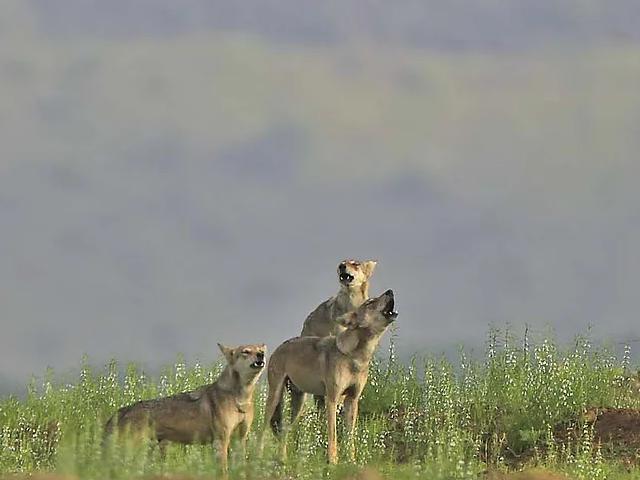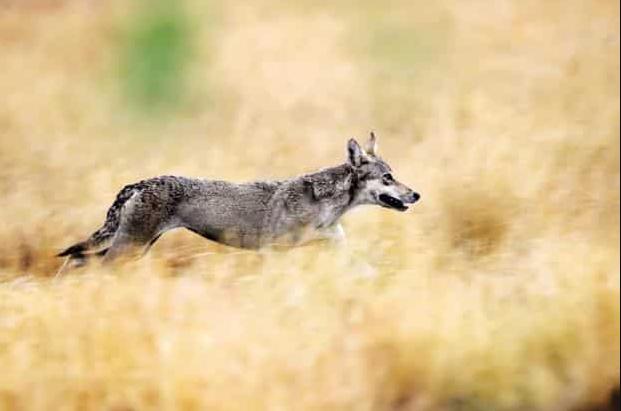What is common between a tiger and wolf? Their population in India is almost similar and so is their level of threat –endangered. Despite the highest level of protection and a project to save tiger, their number was 2967 in the last census in 2018. There are about 3100 wolves left in India. Experts believe that if they are not protected, the Indian wolves may vanish like their grassland cohabitant cheetahs in the past. But now the introduction of cheetahs in Kuno national park of Madhya Pradesh has revived the hopes for the protection of their habitat – savannahs of India. However, there are questions and concerns how protecting the habitat in Kuno would protect other grass and shrub lands of the country. And there seems to be no answers.
Poor Wolf, Doesn’t Howl - Whines
Over the years, a mythical wolf silhouette howling at the full moon created a dark and dangerous image of the carnivore now struggling for survival. But why does a wolf howl? “A wolf will be wasting its time howling at the moon. It does so only to communicate with its pack. Every wolf howl is unique, just like every tiger has a unique stripe pattern on its body," says Bilal Habib, a scientist at the Wildlife Institute of India and an expert on wolves in his study “Howls of India : Assessing endangered wolf populations through howl surveys. The howling keeps the wolf pack together. According to Habib, wolves—like dogs—also bark, whine, whimper, snarl, yelp and growl more often than they howl. However, it is howling that defines the wolf. But shrinking savannahs seem to make the wolf only whine.
Also read: Cheetah in Kuno National Park, Real Challenge Begins Now
A recent study on wolves conducted by Dehradun based the Wildlife Institute o India (WII) says varely 3,100 wolves live in India. “Indian peninsular wolves (Canis lupus pallipes) are an ancient lineage of wolves endemic to the Indian sub-continent”, the study “Distribution, Status, and Conservation of the Indian Peninsular Wolf” says. It was conducted by Yadvendradev Jhala, Swati Saini, Qamar Qureshi all from WII and Satish Kumar from the department of Wildlife Sciences Aligarh Muslim University. India wolves are not as charismatic as tigers or cheetahs and there is no wildlife sanctuary dedicated to it. Unlike other iconic species like the recent example of cheetah, it also doesn’t attract politicians and funding . In the WII study, the highest concentration of wolves was found in Madhya Pradesh (772), followed by Rajasthan (532), Gujarat (494), and Maharashtra (396) and Chhattisgarh (320).
Also read: Lion ,Cheetah And The Politics Of Conservation
“This ancient wolf lineage is threatened by habitat loss due to development, hybridisation with dogs, fast traffic roads, diseases, and severe persecution. Their status is as precarious as that of the tiger but focused conservation efforts are still lacking,” said the study. The study said India had “no conservation or action plan” but urgently needed one to save the wolves. Abi T. Vanak, fellow, Ashoka Trust for Research in Ecology and the Environment and Mihir Godbole write in The Hindu, “ a recent study shows that less than 5% of open natural ecosystems in the country are protected. The wolf, unlike the tiger, is not a creature of forests.” They also said, “ The semi-arid savannah grasslands and rocky areas of the Deccan plateau, in Karnataka, Maharashtra, Telangana and Andhra Pradesh, along with some areas of Gujarat, Madhya Pradesh and Rajasthan are among the last strongholds of the Indian wolf. The word savanna comes from the 16th-century word zavanna, which means “treeless plain.” However, the term is used to describe a more varied habitat, made up of large expanses of grasses, often one or two types that create a continuous carpet, interrupted by scattered shrubs and trees. Pre-Independence, they would have likely shared their habitat with the Asiatic cheetah, coursing down blackbuck and chinkara (Indian gazelle).” The cheetah vanished and so are the vast herds of antelope that roamed the Indian plains. Wolves are unfortunately following the same path and have declined across their entire range, the duo warned.
Give Them Little Space to Survive
Like tigers, lions, elephants and rhinoceros, wolves have also been given the highest protection under the Wildlife (Protection) Act, 1972— listed as a Schedule 1 species. But the implementing agency of the act- the forest department seems to be hardly bothered to achieve the goal of protecting them. The reason, the wolves do not live in forest. Across the world, environmentalists have already begun warning about the dangers of focusing conservation money and efforts around the big four, and other so-called ‘charismatic species’—often at the expense of other less popular but endangered species. Bilal Habib, the WII scientist, has been quoted in media saying, “Wolves cannot be protected by the forest department as it requires looking after large areas. Protecting such big areas is impossible, especially in a country like ours.” According to the government of India’s Wasteland Atlas of India, much of the wolf’s native habitat is barren wastelands that are actively prioritized for development activities.” It is ironic that one of the greatest dangers to grasslands comes from ‘green’ projects such as solar energy and tree planting drives”, experts said. It is a huge challenge to protect the dry grassland ecosystem.
Also read: Game Hunting by Maharajas to Bushmeat Poaching: Blackbucks killed in Thousands
In this backdrop, the Action Plan Cheetah raises hopes. It said: Bringing the cheetah back to India, important in itself, would have equally important conservation ramifications. In saving it one would have to save not only its prey-base comprising certain threatened species, but also other endangered species of the grasslands/ open forest ecosystems, some of which are on the brink of extinction. Amongst these are the caracal (Caracal caracal), the Indian wolf (Canis lupus pallipes) and three endangered species of the bustard family- the Houbara (Chlamydotis undulata macqueenii), the lesser florican (Sypheotides indica) and the most endangered of all, the great Indian bustard (GIB) (Ardeotis nigriceps). The grassland/ open forest dependent species, both avifaunal and faunal, have suffered a more drastic decline than any other species adapted to other biomes, simply because these habitats have undergone the most qualitative and quantitative decimation of all ecotypes in the sub-continent. Experts however, hardly have any faith in it. How would India save its savannahs where cheetahs are not transloated?, they ask.
Also read: Lesser Florican: MP Banishes the Bird Popular for mid- air Romance
The wolf today is vilified and hunted, struggling to find a habitat. This is a far cry from the wolves in legends which raised orphaned children—from Romulus who built Rome to Mowgli in Rudyard Kipling’s Jungle Book. Will the wolf survive the brunt of human development? Ed Bangs, responsible for restoring the Grey wolf species in the US, says, “I’ve always said that the best wolf habitat resides in the human heart. You have to leave a little space for them to live. Indian grey wolves are unlike their European and American counterparts. They are smaller, leaner, highly adapted to the hot, arid plains of the Indian subcontinent. They are, along with the Tibetan wolf found in the Himalayas, among the oldest wolf lineages in the world. If the Indian wolf were to disappear, this ancient evolutionary lineage would be forever lost, and India’s savannas would be bereft of both their top predators.
From:Deshdeep Saxena




Comments
Post a Comment